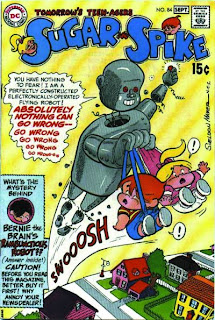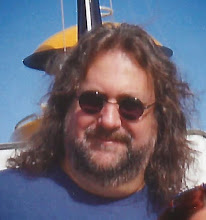 House of Secrets #81
House of Secrets #81 (On Sale: June 3, 1969) has a cover by
Neal Adams as it rejoins the DC ranks after being AWOL for the past three years.
We begin with
"Don't Move It!" by
Mike Friedrich, Jerry Grandenetti and
George Roussos which is the origin story for the
House of Secrets. That is followed by
"House of Secrets" drawn by
Bill Draut and containing the first appearance of
Abel in the
House of Secrets (remember he premiered in last month's
DC Special #4).
Next is a text story,
"Burn This House!" by persons unknown. That is followed by
"Aaron Philips' Photo Finish!" by
Gerry Conway and
Jack Sparling. The issue ends with an
Epilogue to the
"House of Secrets" drawn by
Bill Draut. The entire issue was reprinted in
Showcase Presents: The House of Secrets Vol. 1 TPB.This was
Gerry Conway's first story for DC. Between now and 1990 Gerry would write 630 tales for DC. He began selling such anthological stories here and for Marvel's
Chamber of Darkness and
Tower of Shadows through the end of 1970. He published his first continuing-character story in
The Phantom Stranger #10.
Conway broke into Marvel Comics through Marvel editor
Roy Thomas as he explained in
Back Issue #26:"I'd been writing for DC Comics for two or three years . . . but to paraphrase the joke about the actor's ambitions to be a director, what I really wanted to do was write superheroes — specifically Marvel heroes. Through friends I'd become acquainted with Roy Thomas, who was Stan Lee's right-hand man at the time, and Roy offered me a shot at the Marvel 'writing test'. Stan wasn't impressed, but Roy liked what I did, and began throwing some short assignments my way, including scripting over his plot on an early Ka-Zar [story]...”
Following his first continuing-character story for Marvel, with his script for
Ka-Zar in
Astonishing Tales #3, Conway's began writing superhero stories with
Daredevil #72. He quickly went on to assignments on
Iron Man, The Incredible Hulk, and both
"The Inhumans" and
"The Black Widow" features in
Amazing Adventures. Conway would eventually script virtually every major Marvel title, as well as co-create (with writers
Roy & Dann Thomas and artist
Mike Ploog)
"Werewolf by Night", in
Marvel Spotlight #2; and write the premiere issue of Marvel's
The Tomb of Dracula, introducing the longstanding literary vampire into the Marvel universe. He scripted the first
Man-Thing story, in 1971, sharing co-creation credit with
Stan Lee and
Roy Thomas.

At 19, Conway began scripting
The Amazing Spider-Man, one of Marvel's flagship titles. His run, from issues #111–149, included the landmark death of
Gwen Stacy story in #121. Eight issues later, Conway and
Ross Andru introduced
the Punisher as a conflicted antagonist for
Spider-Man. The character went on to become a popular star of numerous comic books and has been adapted into three movies. Conway additionally scripted Marvel's other flagship,
Fantastic Four, from #133–152.
Gerry Conway succeeded
Marv Wolfman as editor-in-chief of Marvel Comics in mid-1976, but held the job only briefly, relinquishing the post before the year was out and succeeded in turn by
Archie Goodwin.
Conway returned to DC Comics in mid-1975, beginning with three books cover-dated Nov. 1975:
Hercules Unbound #1, Kong the Untamed #3, and
Swamp Thing #19. Shortly afterward, he was chosen by Marvel and DC editors to script the historic inter-company crossover
Superman vs. the Amazing Spider-Man #1, a 96-page, tabloid-sized, $2 one-shot, at a time when comic books sold for 25 cents.
He continued writing for DC, on titles including
Superman, Detective Comics (starring
Batman),
Metal Men, Justice League of America, 1st Issue Special #11 starring
Codename: Assassin, and that of the licensed character
Tarzan, yet briefly returned to Marvel as editor in mid-1976. For a time, a confluence of publishing schedules resulted in Conway stories appearing in both Marvel and DC comics in the same month.
After leaving Marvel's editorship, he again wrote exclusively for DC, writing both major and lesser titles — from those featuring
Superman, Batman, Wonder Woman, the Justice League of America, and the
Legion of Super-Heroes to such books as
Weird Western Tales, Atari Force and
Sun Devils — through mid-1986. His co-creation
Firestorm, "the Nuclear Man", debuted in the eponymous
Firestorm #1, which lasted five issues before being canceled during a 1978 DC retrenchment. The character then starred in a backup feature in
The Flash before again receiving his own series,
The Fury of Firestorm (later
Firestorm the Nuclear Man), from June 1982 – August 1990; Conway wrote most of the first half of the run, plus four of its five annuals.
Conway returned to Marvel in the 1980s and served as the regular writer of both
The Spectacular Spider-Man and
Web of Spider-Man from 1988 until 1990. He relinquished writing duties on both titles when he became the script-editor of TV's
Father Dowling Mysteries.
Conway's last recorded comics credit is Topps Comics'
"Kirbyverse" one-shot
NightGlider #1 , scripting from a
Roy Thomas plot.
In addition to comics, Conway published two science-fiction novels:
The Midnight Dancers and
Mindship. He also wrote the February 14 - December 3, 1983 dailies of the syndicated newspaper comic strip
Star Trek.
Conway as well moved into screenwriting in the 1980s, starting with the animated feature
Fire and Ice in 1983, co-written with
Roy Thomas, based on characters created by
Ralph Bakshi and
Frank Frazetta. Conway and Thomas wrote the story basis for
Stanley Mann's screenplay for the film
Conan the Destroyer.
Conway went on to write, and eventually produce, for such TV series as
Diagnosis Murder, Matlock, Jake and the Fatman, Father Dowling Mysteries, Hercules: The Legendary Journeys, Baywatch Nights, Pacific Blue, Silk Stalkings, Perry Mason telefilms, Law & Order, The Huntress, Law & Order: Criminal Intent, and an episode of
Batman: The Animated Series.
Edited by
Joe Orlando.
 Girls' Love Stories #145 (On Sale: June 26, 1969) has another sexy cover by Nick Cardy.
Girls' Love Stories #145 (On Sale: June 26, 1969) has another sexy cover by Nick Cardy.








































